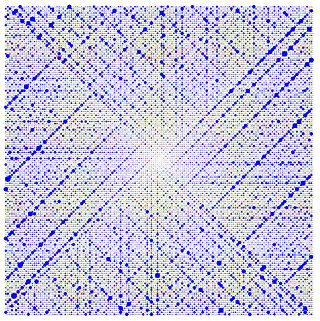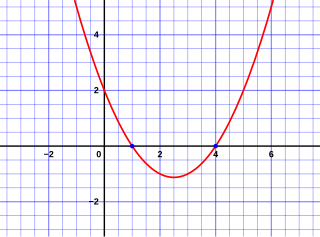This problem was given in India by the mathematician Brahmagupta in 628 AD in his treatise Brahma Sputa Siddhanta :
Solve the Pell's equation
for integers .
Brahmagupta gave the smallest solution as
- .
This problem was given in India by the mathematician Brahmagupta in 628 AD in his treatise Brahma Sputa Siddhanta :
Solve the Pell's equation
for integers .
Brahmagupta gave the smallest solution as
Weisstein, Eric W. "Brahmagupta's Problem". MathWorld .

In mathematics, a Diophantine equation is an equation, typically a polynomial equation in two or more unknowns with integer coefficients, for which only integer solutions are of interest. A linear Diophantine equation equates to a constant the sum of two or more monomials, each of degree one. An exponential Diophantine equation is one in which unknowns can appear in exponents.

Number theory is a branch of pure mathematics devoted primarily to the study of the integers and arithmetic functions. German mathematician Carl Friedrich Gauss (1777–1855) said, "Mathematics is the queen of the sciences—and number theory is the queen of mathematics." Number theorists study prime numbers as well as the properties of mathematical objects constructed from integers, or defined as generalizations of the integers.

Pell's equation, also called the Pell–Fermat equation, is any Diophantine equation of the form where n is a given positive nonsquare integer, and integer solutions are sought for x and y. In Cartesian coordinates, the equation is represented by a hyperbola; solutions occur wherever the curve passes through a point whose x and y coordinates are both integers, such as the trivial solution with x = 1 and y = 0. Joseph Louis Lagrange proved that, as long as n is not a perfect square, Pell's equation has infinitely many distinct integer solutions. These solutions may be used to accurately approximate the square root of n by rational numbers of the form x/y.
In algebra, a quadratic equation is any equation that can be rearranged in standard form as

In elementary algebra, the quadratic formula is a formula that provides the solutions to a quadratic equation. Other ways of solving a quadratic equation, such as completing the square, yield the same solutions.
In mathematics, a Diophantine equation is an equation of the form P(x1, ..., xj, y1, ..., yk) = 0 (usually abbreviated P(x, y) = 0) where P(x, y) is a polynomial with integer coefficients, where x1, ..., xj indicate parameters and y1, ..., yk indicate unknowns.

In mathematics, a negative number represents an opposite. In the real number system, a negative number is a number that is less than zero. Negative numbers are often used to represent the magnitude of a loss or deficiency. A debt that is owed may be thought of as a negative asset. If a quantity, such as the charge on an electron, may have either of two opposite senses, then one may choose to distinguish between those senses—perhaps arbitrarily—as positive and negative. Negative numbers are used to describe values on a scale that goes below zero, such as the Celsius and Fahrenheit scales for temperature. The laws of arithmetic for negative numbers ensure that the common-sense idea of an opposite is reflected in arithmetic. For example, − (−3) = 3 because the opposite of an opposite is the original value.
Brahmagupta was an Indian mathematician and astronomer. He is the author of two early works on mathematics and astronomy: the Brāhmasphuṭasiddhānta, a theoretical treatise, and the Khaṇḍakhādyaka, a more practical text.
In algebra, the Brahmagupta–Fibonacci identity expresses the product of two sums of two squares as a sum of two squares in two different ways. Hence the set of all sums of two squares is closed under multiplication. Specifically, the identity says
In mathematics, an algebraic equation or polynomial equation is an equation of the form , where P is a polynomial with coefficients in some field, often the field of the rational numbers. For example, is an algebraic equation with integer coefficients and

In mathematics, a square triangular number is a number which is both a triangular number and a square number. There are infinitely many square triangular numbers; the first few are:

Bhāskara II, also known as Bhāskarāchārya, and as Bhāskara II to avoid confusion with Bhāskara I, was an Indian mathematician, astronomer and inventor. From verses in his main work, Siddhāṁta Śiromaṇī (सिद्धांतशिरोमणी), it can be inferred that he was born in 1114 in Vijjadavida (Vijjalavida) and living in the Satpuda mountain ranges of Western Ghats, believed to be the town of Patana in Chalisgaon, located in present-day Khandesh region of Maharashtra by scholars. He is the only ancient mathematician who has been immortalized on a monument. In a temple in Maharashtra, an inscription supposedly created by his grandson Changadeva, lists Bhaskaracharya's ancestral lineage for several generations before him as well as two generations after him. Colebrooke who was the first European to translate (1817) Bhaskaracharya II's mathematical classics refers to the family as Maharashtrian Brahmins residing on the banks of the Godavari.
Bhāskara was a 7th-century Indian mathematician and astronomer who was the first to write numbers in the Hindu–Arabic decimal system with a circle for the zero, and who gave a unique and remarkable rational approximation of the sine function in his commentary on Aryabhata's work. This commentary, Āryabhaṭīyabhāṣya, written in 629 CE, is among the oldest known prose works in Sanskrit on mathematics and astronomy. He also wrote two astronomical works in the line of Aryabhata's school: the Mahābhāskarīya and the Laghubhāskarīya.
Indian mathematics emerged in the Indian subcontinent from 1200 BCE until the end of the 18th century. In the classical period of Indian mathematics, important contributions were made by scholars like Aryabhata, Brahmagupta, Bhaskara II, and Varāhamihira. The decimal number system in use today was first recorded in Indian mathematics. Indian mathematicians made early contributions to the study of the concept of zero as a number, negative numbers, arithmetic, and algebra. In addition, trigonometry was further advanced in India, and, in particular, the modern definitions of sine and cosine were developed there. These mathematical concepts were transmitted to the Middle East, China, and Europe and led to further developments that now form the foundations of many areas of mathematics.
In mathematics, a binary quadratic form is a quadratic homogeneous polynomial in two variables
The chakravala method is a cyclic algorithm to solve indeterminate quadratic equations, including Pell's equation. It is commonly attributed to Bhāskara II, although some attribute it to Jayadeva. Jayadeva pointed out that Brahmagupta's approach to solving equations of this type could be generalized, and he then described this general method, which was later refined by Bhāskara II in his Bijaganita treatise. He called it the Chakravala method: chakra meaning "wheel" in Sanskrit, a reference to the cyclic nature of the algorithm. C.-O. Selenius held that no European performances at the time of Bhāskara, nor much later, exceeded its marvellous height of mathematical complexity.
In mathematics, the following matrix was given by Indian mathematician Brahmagupta:
In algebra, Brahmagupta's identity says that, for given , the product of two numbers of the form is itself a number of that form. In other words, the set of such numbers is closed under multiplication. Specifically:
Algebra can essentially be considered as doing computations similar to those of arithmetic but with non-numerical mathematical objects. However, until the 19th century, algebra consisted essentially of the theory of equations. For example, the fundamental theorem of algebra belongs to the theory of equations and is not, nowadays, considered as belonging to algebra.
Brahmagupta polynomials are a class of polynomials associated with the Brahmagupa matrix which in turn is associated with the Brahmagupta's identity. The concept and terminology were introduced by E. R. Suryanarayan, University of Rhode Island, Kingston in a paper published in 1996. These polynomials have several interesting properties and have found applications in tiling problems and in the problem of finding Heronian triangles in which the lengths of the sides are consecutive integers.